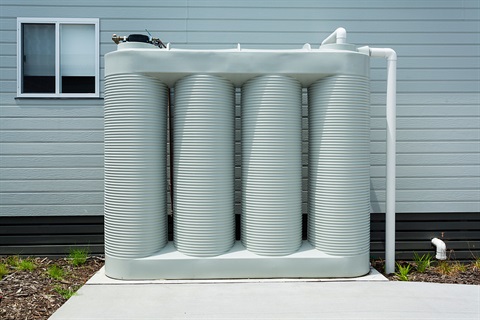Rainwater tanks

Installing a rainwater tank helps you to capture and store water for use in your home during drier seasons.
Capturing rainwater means you:
- use less mains water
- save money on water bills
- help preserve reservoir supplies during droughts
- help reduce the amount of water lost to storm water when it rains.
Rainwater tank size
How much water you need depends on:
- the number of people in your household
- the efficiency of your appliances
- your water using activities.
Calculator
Use the rainwater tank calculator to work out what size rainwater tank you need for your home.
Continuous supply
Your rainwater tank must be interconnected to the mains water system to ensure you always have a supply of water.
Automatic valves can switch the supply between rainwater and mains without interruption.
A backflow prevention device must also be installed to prevent rainwater being drained back into the mains supply.
Connecting a tank to mains water
Your rainwater tank must be connected to a mains tap or appliance by a licensed plumber.
Unless you’re installing a gravity feed system, you will need a pump to feed the water into the house. There are specific installation requirements and pipe work must be clearly marked 'rainwater'.
A Certificate of Compliance must be completed by the plumber to certify that the installation meets the required standard.
A copy must be lodged with SA Water. Keep a copy for your own records.
Rainwater safety
The quality of rainwater can vary depending on:
- gutter and tank maintenance
- where it’s located
- proximity to airborn pollution such as roads and factories.
For a clean water supply fit for your household purposes regular maintenance is needed.
Rainwater tank maintenance
To minimise risk of contamination:
- keep gutters clean
- maintain filter screens
- drain and clean the tank every few years to remove sediment
- connect a first flush device.
Drinking rainwater
Health authorities advise that rainwater is safe for most people to drink providing:
- it is clear
- has little taste or smell
- it comes from a well maintained system.
If these conditions are observed then the chances of having harmful organisms in your rainwater tank is expected to be low.
If you have concerns you can have your rainwater tested by a laboratory.
Find out more about having your rainwater tested
For the elderly, the very young or anyone with compromised health it is recommended to boil rainwater to sterilise it first before drinking.
Rainwater tank tests
Contact SA Water to have your rainwater tested (fees apply).
Types of tanks
There are many different types of rainwater tanks available from specialised suppliers and local hardware stores.
Before making a decision speak with an industry professional.
Rainwater tank rebates
Residents of West Torrens may be eligible for a rainwater tank rebate on the cost of a new tank. Find out more
More information
Find an accredited rainwater tank installer